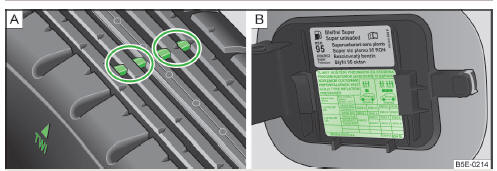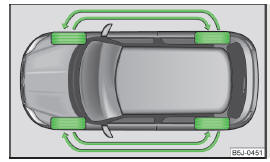
Skoda Fabia: Tyre service life
Skoda Fabia Owners Manual

Fig. 133 Principle sketch: Tyre tread with wear indicators/Open fuel filler
flap with a table detailing the tyre sizes and tyre pressures

Fig. 134 Swapping wheels around
The life of tyres depends on the pressure, driving style, and other circumstances.
Following the advice below can extend the service life of your tyres.
Tyre pressure
Check the tyre pressure, including that of the spare wheel, at least once a month and also before setting off on a long journey.
The tyre pressures for tyres are shown on the inside of the fuel filler flap » Fig. 133 – B.
The tyre pressure should be at the highest pressure specified for your vehicle at all times.
Always check the inflation pressure when the tyres are cold. Do not reduce the higher pressure of warm tyres.
Adjust the tyre pressure accordingly if you are carrying a greater load.
Driving style
Fast cornering, sharp acceleration and braking increase the wear of your tyres.
Balancing wheels
The wheels of a new vehicle are balanced. There are a wide range of influences when the car is being driven which may result in an imbalance. This may become apparent by “vibration” in the steering.
Have the wheels rebalanced after replacing the tyres.
Wheel alignment errors
Incorrect wheel alignment at the front or rear leads to excess wear on the tyres.
Tyre damage
Drive over kerbs and other such obstacles slowly and at right angles wherever possible in order to avoid damage to tyres and wheel trims.
We recommend checking your tyres and wheel rims for damage (punctures, cuts, splits and bulges, etc.) on a regular basis. Remove foreign bodies (e.g.
small stones) from the tyre profile immediately.
Swapping wheels around
If significantly greater wear is present on the front tyres, we recommend swapping the front wheels with the rear wheels as shown in the diagram » Fig. 134. You will then obtain approximately the same life for all the tyres.
We recommend that you swap the tyres around every 10,000 km in order to achieve even wear on all tyres and to obtain optimal tyre life.
Storing tyres
Mark the tyres as you remove them so that you are able to refit them to run in the same direction.
Always store wheels or tyres in a cool, dry and, where possible, dark place.
Tyres which are not fixed to a wheel trim should be stored upright.
Wear indicators
The base of the tread of the tyres has 1.6 mm high wear indicators installed.
These wear indicators are arranged evenly spaced around the circumference of the tyre a number of times depending on the make » Fig. 133 - A. Markings on the walls of the tyres through the letters “TWI”, triangular symbols or other symbols identify the position of the wear indicators.
Tyre age
Tyres age losing their original characteristics, even if they are not used. Therefore, we recommend that you do not use summer or winter tyres that are older than 6 years or 4 years respectively.
Other info:
Citroen C3. Advice on child seats
The incorrect installation of a child
seat in a vehicle compromises the
child's protection in the event of an
accident.
Remember to fasten the seat belts or
the child seat harnesses keeping t ...
Peugeot 208. 12 V battery
The battery does not require any maintenance. However, check that the terminals
are clean and correctly tightened, particularly in summer and winter.
When carrying out work on the battery, refer ...
Honda Fit. Opening the Hood
1. Park the vehicle on a level surface, and set
the parking brake.
2. Pull the hood release handle under the
lower left corner of the dashboard.
► The hood will pop up slightly.
3. Push ...
Manuals For Car Models
-
 Chevrolet Sonic
Chevrolet Sonic -
 Citroen C3
Citroen C3 -
 Fiat Punto
Fiat Punto -
 Honda Fit
Honda Fit -
 Mazda 2
Mazda 2 -
 Nissan Micra
Nissan Micra -
 Peugeot 208
Peugeot 208 -
 Renault Clio
Renault Clio -
 Seat Ibiza
Seat Ibiza -
 Skoda Fabia
Skoda Fabia - Honda Pilot
- Volkswagen ID4
- Toyota Prius


